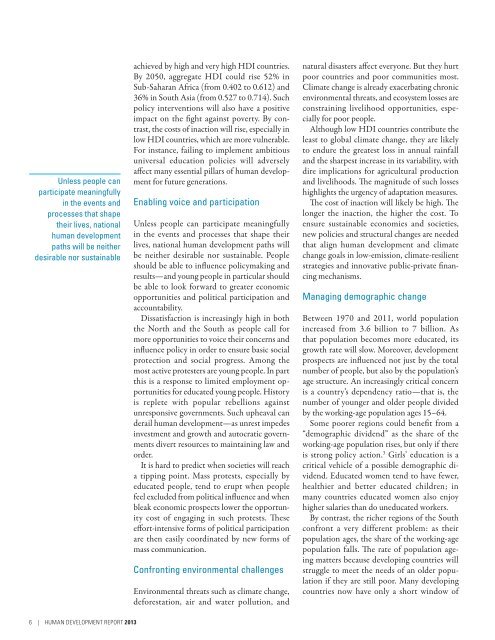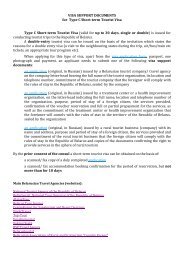Human Development Report 2013 - UNDP
Human Development Report 2013 - UNDP
Human Development Report 2013 - UNDP
You also want an ePaper? Increase the reach of your titles
YUMPU automatically turns print PDFs into web optimized ePapers that Google loves.
Unless people canparticipate meaningfullyin the events andprocesses that shapetheir lives, nationalhuman developmentpaths will be neitherdesirable nor sustainableachieved by high and very high HDI countries.By 2050, aggregate HDI could rise 52% inSub-Saharan Africa (from 0.402 to 0.612) and36% in South Asia (from 0.527 to 0.714). Suchpolicy interventions will also have a positiveimpact on the fight against poverty. By contrast,the costs of inaction will rise, especially inlow HDI countries, which are more vulnerable.For instance, failing to implement ambitiousuniversal education policies will adverselyaffect many essential pillars of human developmentfor future generations.Enabling voice and participationUnless people can participate meaningfullyin the events and processes that shape theirlives, national human development paths willbe neither desirable nor sustainable. Peopleshould be able to influence policymaking andresults—and young people in particular shouldbe able to look forward to greater economicopportunities and political participation andaccountability.Dissatisfaction is increasingly high in boththe North and the South as people call formore opportunities to voice their concerns andinfluence policy in order to ensure basic socialprotection and social progress. Among themost active protesters are young people. In partthis is a response to limited employment opportunitiesfor educated young people. Historyis replete with popular rebellions againstunresponsive governments. Such upheaval canderail human development—as unrest impedesinvestment and growth and autocratic governmentsdivert resources to maintaining law andorder.It is hard to predict when societies will reacha tipping point. Mass protests, especially byeducated people, tend to erupt when peoplefeel excluded from political influence and whenbleak economic prospects lower the opportunitycost of engaging in such protests. Theseeffort-intensive forms of political participationare then easily coordinated by new forms ofmass communication.Confronting environmental challengesEnvironmental threats such as climate change,deforestation, air and water pollution, andnatural disasters affect everyone. But they hurtpoor countries and poor communities most.Climate change is already exacerbating chronicenvironmental threats, and ecosystem losses areconstraining livelihood opportunities, especiallyfor poor people.Although low HDI countries contribute theleast to global climate change, they are likelyto endure the greatest loss in annual rainfalland the sharpest increase in its variability, withdire implications for agricultural productionand livelihoods. The magnitude of such losseshighlights the urgency of adaptation measures.The cost of inaction will likely be high. Thelonger the inaction, the higher the cost. Toensure sustainable economies and societies,new policies and structural changes are neededthat align human development and climatechange goals in low-emission, climate-resilientstrategies and innovative public-private financingmechanisms.Managing demographic changeBetween 1970 and 2011, world populationincreased from 3.6 billion to 7 billion. Asthat population becomes more educated, itsgrowth rate will slow. Moreover, developmentprospects are influenced not just by the totalnumber of people, but also by the population’sage structure. An increasingly critical concernis a country’s dependency ratio—that is, thenumber of younger and older people dividedby the working-age population ages 15–64.Some poorer regions could benefit from a“demographic dividend” as the share of theworking-age population rises, but only if thereis strong policy action. 3 Girls’ education is acritical vehicle of a possible demographic dividend.Educated women tend to have fewer,healthier and better educated children; inmany countries educated women also enjoyhigher salaries than do uneducated workers.By contrast, the richer regions of the Southconfront a very different problem: as theirpopulation ages, the share of the working-agepopulation falls. The rate of population ageingmatters because developing countries willstruggle to meet the needs of an older populationif they are still poor. Many developingcountries now have only a short window of6 | HUMAN DEVELOPMENT REPORT <strong>2013</strong>
















